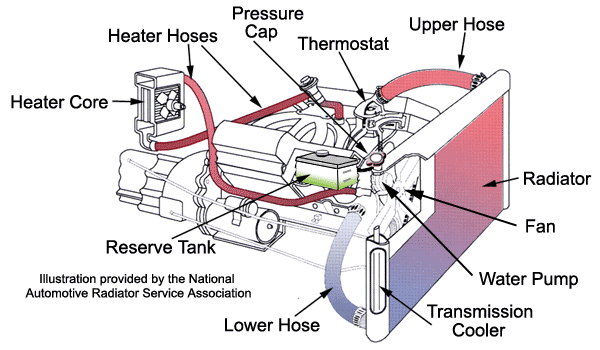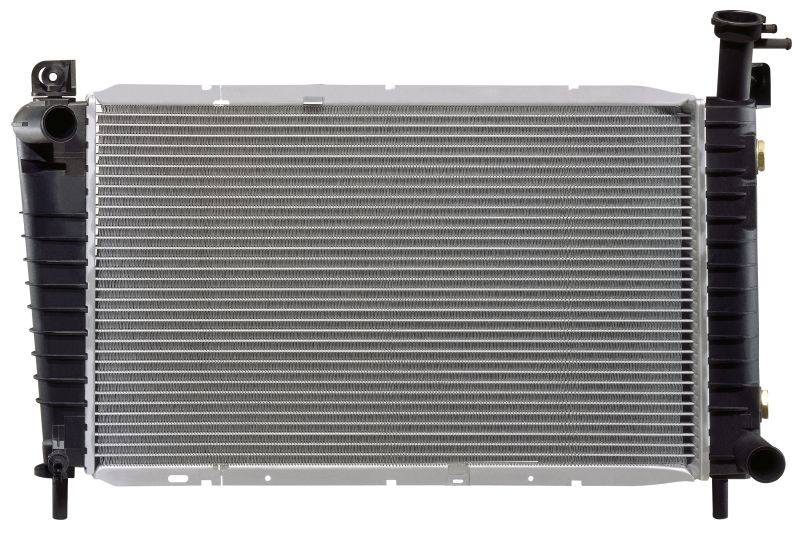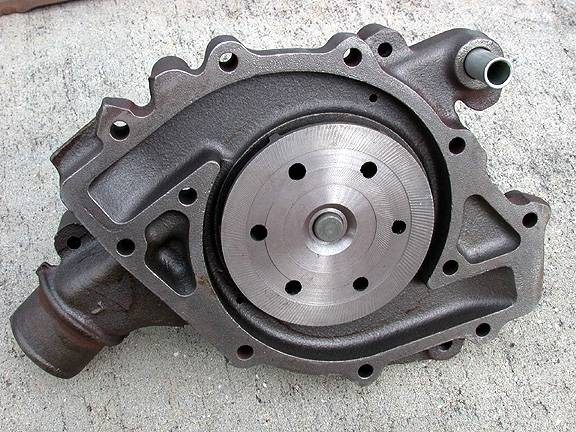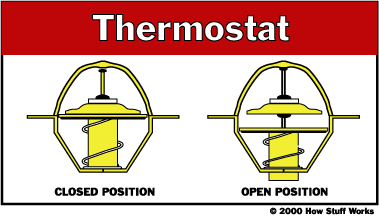The Physics in Cars
The Cooling System
The cooling system is another important and critical part of the car as it keeps the engine from overheating and burning up. The engine of a car is an energy converter that takes the energy in the fuel and compresses and burns it to release the energy in the form of motion. The act of burning this gas is highly inefficient though since there is large amounts of thermal energy that is produced as well as the explosive force that is produced which is the actual part that moves the car. The thermal energy is not needed though which leads to the problem of what to do with it. This is where the cooling system comes into play with 3 major parts including the radiator, water pump, and thermostat.

(lestroilesroses.net Cooling) Cooling system overview.
The first part of the system that is most recognizable is the radiator. The radiator is the large flat panel in the front of the car usually made of aluminum that allows air to flow through it and exchanges heat as it does so. The way that it works is there is veins that run through the horizontal plane that have coolant that flows through it and little fins that branch off of it that absorb the heat. As the air passes over the fins the heat is removed from the space and cools the liquid. This is considered radiation of heat. The liquid coolant is then pushed back into the engine and more heated coolant flows through the radiator to be cooled down. There is also a fan attached to the engine that helps pull air through the radiator when the car is stationary or moving slowly and would not otherwise cool the car down enough.

(mrradiator.com Cooling) Image of an aluminum radiator.
The next part is the water pump, which is a just as the name suggest, is a pump that pumps and circulates water or coolant throughout the engine and makes sure that everything is getting cooled properly and removing heat that would cause the engine to run inefficiently or overheat. The pump rotates an impeller that pulls water from one side and pushes it through the rest of the engine. As the coolant circulates around the engine it absorbs heat which means the particles pick up energy and are pumped to the radiator where the heat is then released into air.

(ehow.com Cooling) Back side of a water pump.
The last part is the thermostat which is one of the most interesting parts of the cooling system as it is essentially a plug that will open and close on its own based on a preset temperature. The thermostat works because it has a cylinder on it that reacts to the heat by expanding and opening the valve once it hits a certain temperature. This opening is done by a wax that fills the cylinder, when it is cool it is compressed but as the molecules heat up the wax melts and begins to expand pusing on the valve. Once the coolant reaches a certain temperature the thermostat starts to open up and allow the hot coolant out to the radiator and cooler coolant into the engine. This keeps the engine at optimal operating temperatures which allow the engine to run at its most efficient levels for what it can do.

(howstuffworks.com Cooling) Operation of a thermostat

The cooling system is another important and critical part of the car as it keeps the engine from overheating and burning up. The engine of a car is an energy converter that takes the energy in the fuel and compresses and burns it to release the energy in the form of motion. The act of burning this gas is highly inefficient though since there is large amounts of thermal energy that is produced as well as the explosive force that is produced which is the actual part that moves the car. The thermal energy is not needed though which leads to the problem of what to do with it. This is where the cooling system comes into play with 3 major parts including the radiator, water pump, and thermostat.

(lestroilesroses.net Cooling) Cooling system overview.
The first part of the system that is most recognizable is the radiator. The radiator is the large flat panel in the front of the car usually made of aluminum that allows air to flow through it and exchanges heat as it does so. The way that it works is there is veins that run through the horizontal plane that have coolant that flows through it and little fins that branch off of it that absorb the heat. As the air passes over the fins the heat is removed from the space and cools the liquid. This is considered radiation of heat. The liquid coolant is then pushed back into the engine and more heated coolant flows through the radiator to be cooled down. There is also a fan attached to the engine that helps pull air through the radiator when the car is stationary or moving slowly and would not otherwise cool the car down enough.

(mrradiator.com Cooling) Image of an aluminum radiator.
The next part is the water pump, which is a just as the name suggest, is a pump that pumps and circulates water or coolant throughout the engine and makes sure that everything is getting cooled properly and removing heat that would cause the engine to run inefficiently or overheat. The pump rotates an impeller that pulls water from one side and pushes it through the rest of the engine. As the coolant circulates around the engine it absorbs heat which means the particles pick up energy and are pumped to the radiator where the heat is then released into air.

(ehow.com Cooling) Back side of a water pump.
The last part is the thermostat which is one of the most interesting parts of the cooling system as it is essentially a plug that will open and close on its own based on a preset temperature. The thermostat works because it has a cylinder on it that reacts to the heat by expanding and opening the valve once it hits a certain temperature. This opening is done by a wax that fills the cylinder, when it is cool it is compressed but as the molecules heat up the wax melts and begins to expand pusing on the valve. Once the coolant reaches a certain temperature the thermostat starts to open up and allow the hot coolant out to the radiator and cooler coolant into the engine. This keeps the engine at optimal operating temperatures which allow the engine to run at its most efficient levels for what it can do.

(howstuffworks.com Cooling) Operation of a thermostat